2006
Heikki Lunta in the everyday
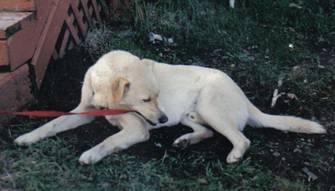 |
| Heikki Lunta the Dog, Hancock, Michigan, circa 1995. Denny’s son Nick, native to the Copper Country, had Heikki the dog as a college student at Michigan Technological University in Houghton during the 1990s. Photo Courtesy of Denny DeCovich. |
When a folklore character is truly embedded into the social consciousness, he becomes part of the everyday, as evidenced through small-group folklore. These traditions include informal actions, such as jokes, sayings, nicknaming, and casual invocations of Heikki Lunta.
Everyday uses of Heikki Lunta prove the value he has in the community. His many meanings touch people of many backgrounds, crossing lines of age, wealth, ethnicity, and residence.
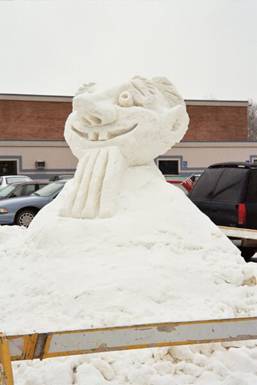 |
| Heikki Lunta snow sculpture, Laskiainen festival, Palo, Minnesota, February 1, 2003. Photograph by Tim Winkle, courtesy SaintUrho.com |
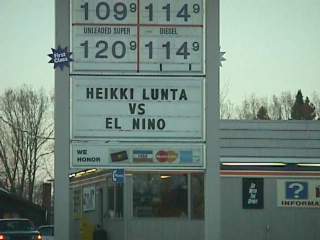 |
| Mine Street Station, Calumet, MI, 1998. Image Courtesy Pasty Cam. |
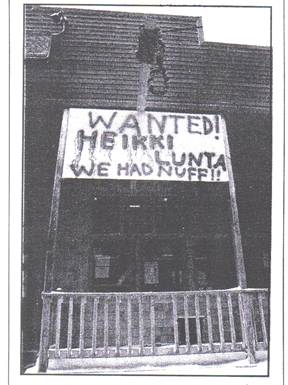 |
| Display outside of Finders and Keepers thrift store featuring a noose and the caption, “Wanted: Heikki Lunta. We had ‘nuff!!” Calumet, Michigan, April 30, 1996. Photograph by Karin Emond/Daily Mining Gazette. |
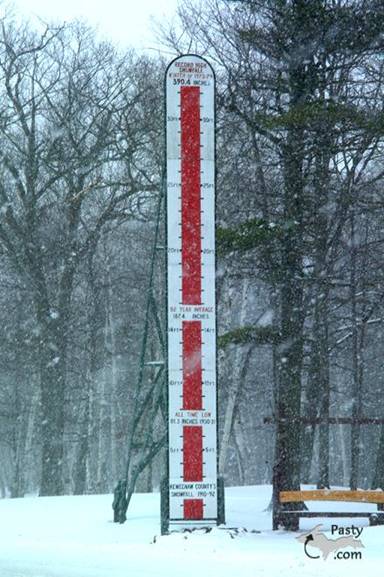 |
| Snow “thermometer” on US Highway 41 south of Delaware records the record snowfall of 1978-79 at 390.6 inches- over 32 feet! Average snowfall is 167.4 inches. Photo used with permission from Pasty Cam. |
He is as useful to community leaders in Hancock, Michigan, as he is to a snowmobile enthusiast in Illinois.
Heikki Lunta can be found most frequently wherever there are Finnish-Americans and wherever there is an abundance of snow. He can be incorporated into festivals of an ethnic nature, and those in celebration of winter and nature. An example of this includes the Heikki Lunta snow statue erected at the Laskiainen festival in Palo, Minnesota. Laskiainen, celebrated during Lent in Finland as a sledding event and winter festival, is celebrated in this community as a combination ethnic and winter festival. Heikki Lunta, as a symbol of ethnic pride, and of snow itself, fits perfectly into the design of Palo’s celebration. Because of his pervasive use throughout the Finnish and Upper Michigan community, he is considered to be a key symbol, a cultural icon that serves to represent numerous facets of the people who use him. At the same time that he reminds us of our immediate ancestors from Upper Michigan, he also represents ancient shamanic roots from Finland. He represents the ability to take pride in that which others may not understand and even deride.
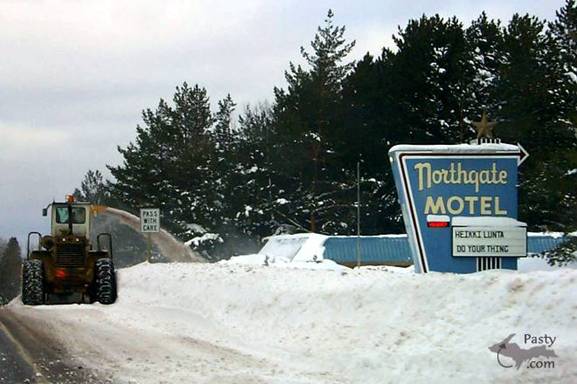 |
| Pro-Heikki Lunta signage outside of the Northgate Motel, Calumet, MI, c. 1999. It would appear that Heikki has, indeed, done his thing. Image courtesy Pasty Cam. |
Heikki Lunta is referenced in public spaces with great frequency in his home region. This, too, reveals his presence in the public consciousness. Those who do not understand the reference mark themselves as non-local and uninitiated, and their understandable mispronunciation of Heikki’s name can be a source of amusement for locals. Such Heikki Lunta references are a winter occurrence, during the season when businesses in the tourism industry depend on the abundant snow for their livelihood.
Today, the tradition continues that Heikki Lunta must be driven out of the community, as the wanted sign and noose reveal. Just as too much snow is a bad thing, so too, is too much ethnic and cultural pride. By alternately embracing and driving Heikki Lunta away, people participate in a dialog of social meaning in the Finnish ethnic and Upper Michigan cultural community. When Heikki Lunta leaves, so too, do winter tourists, with their own positive and negative attributes for the local community. When Heikki Lunta comes, locals and non-locals meet in a space in which they may confront their perceptions and air opinions and feelings normally kept below the surface.
Heikki Lunta was created and continues to survive in the communities of Upper Michigan and Finnish America because he represents deeply ingrained images of an immigrant past that is rapidly receding and he also addresses issues of marginalization that continue to result from the legacy of the immigrant ancestors. Through reflecting on community culture through Heikki Lunta, one celebrates numerous facets of the unique heritage that the Snow God represents.






